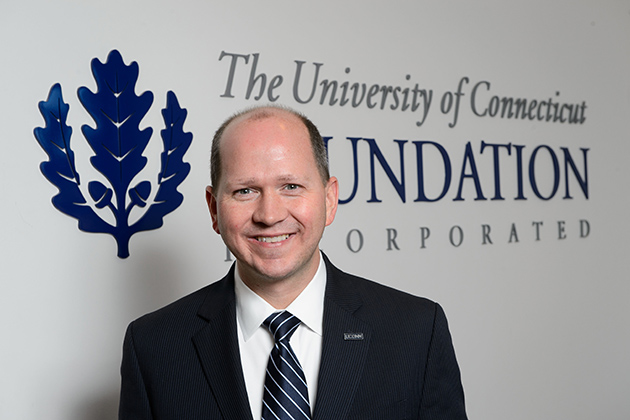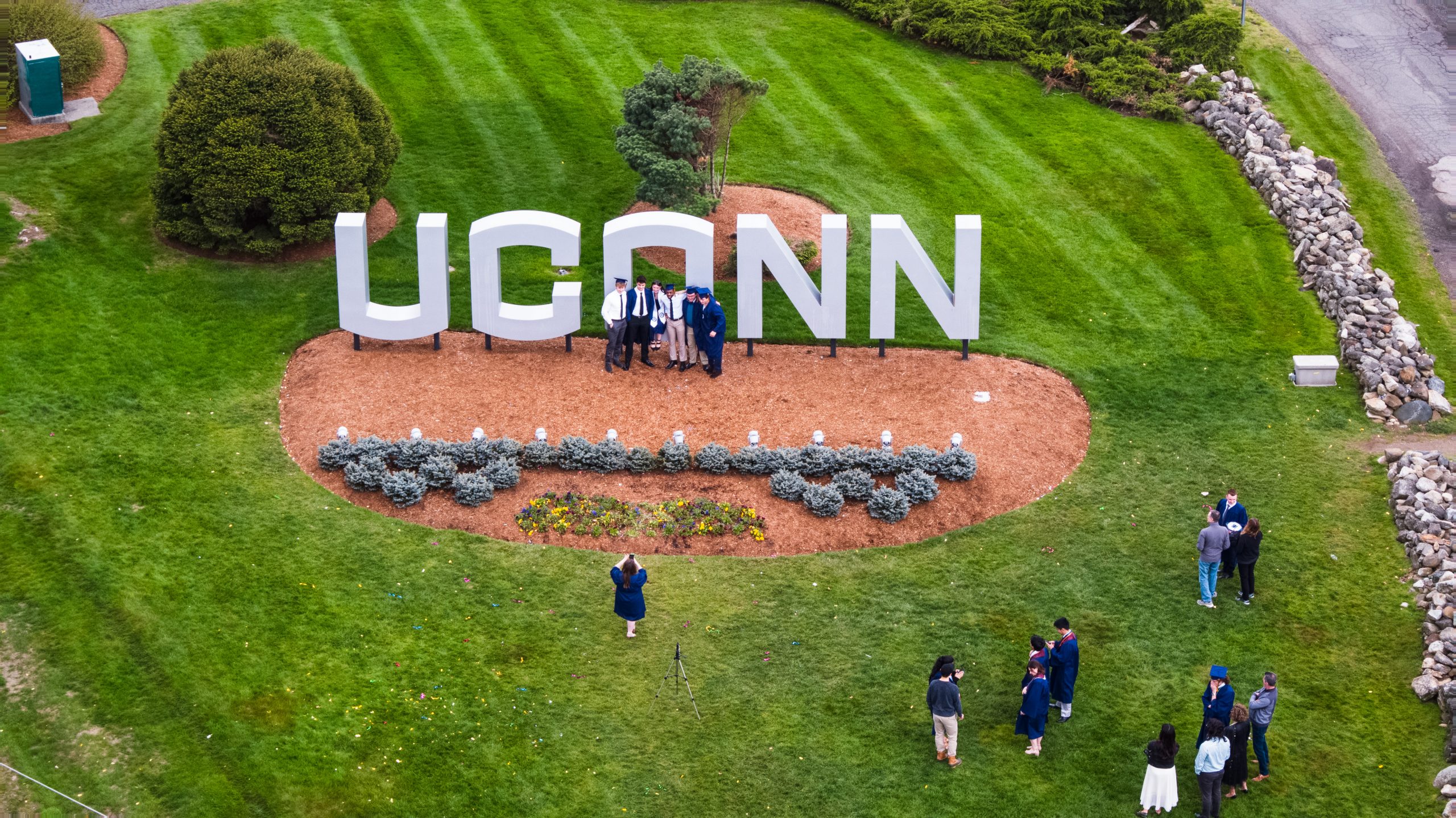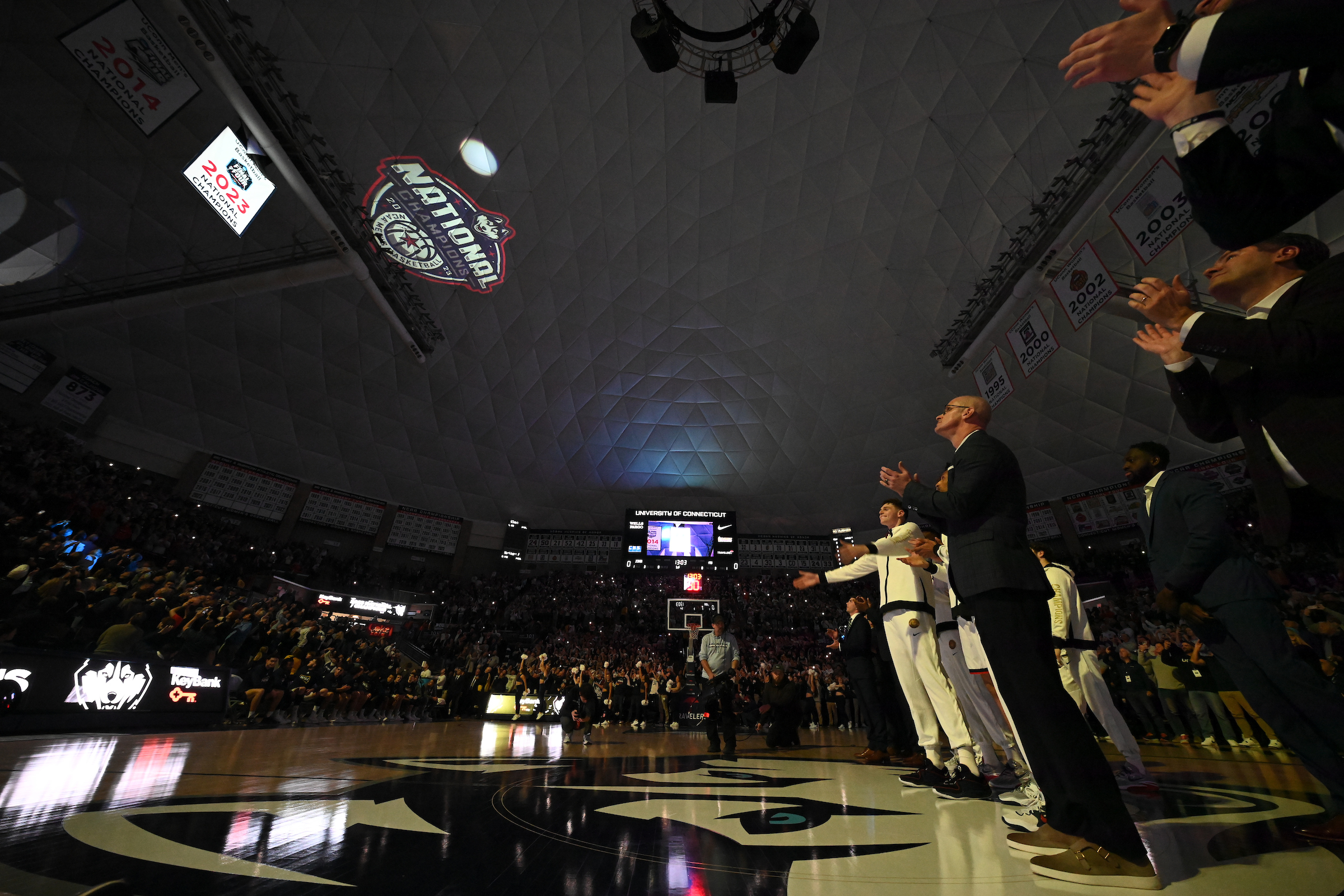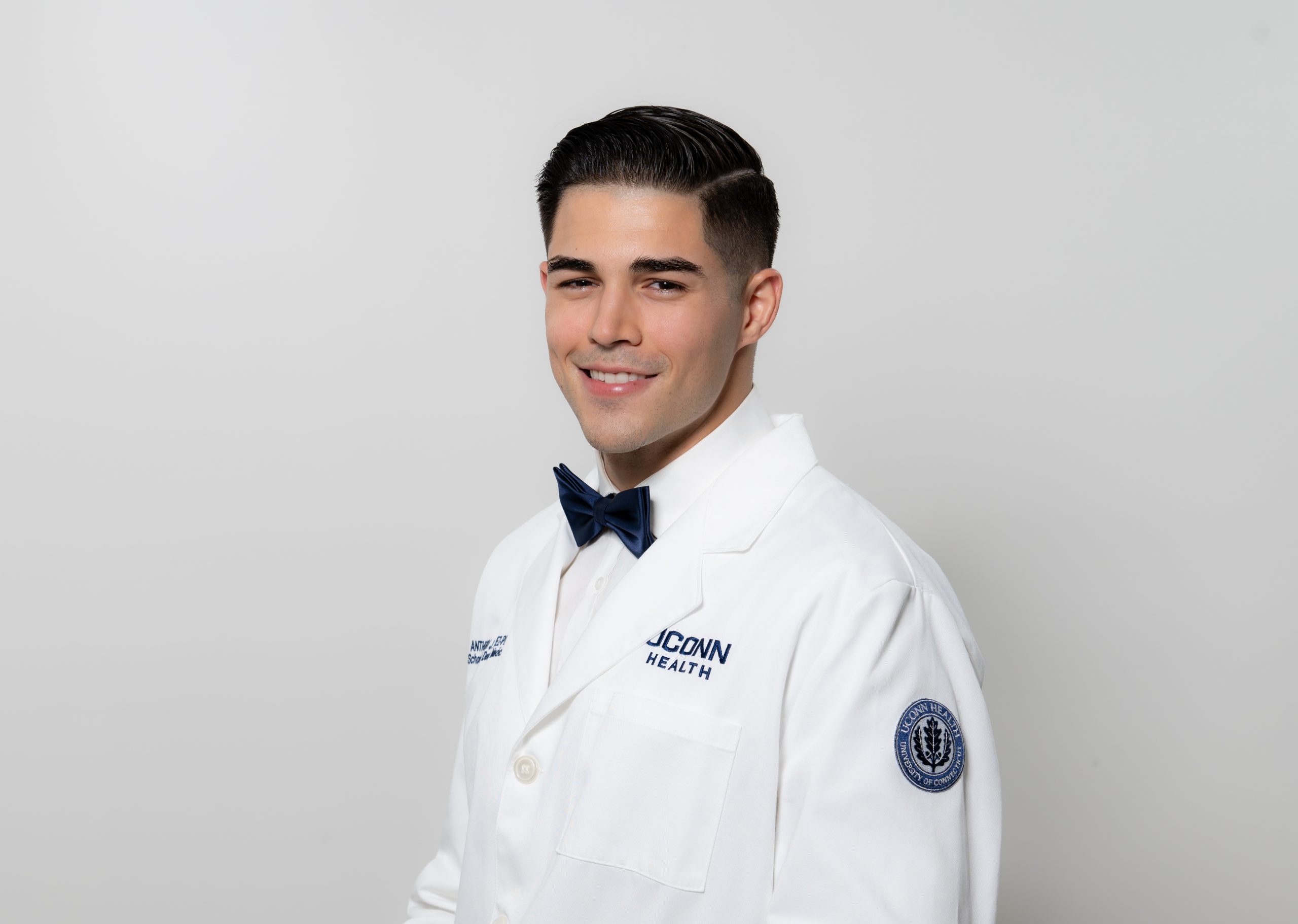
Joshua Newton was named the president of the UConn Foundation last July, arriving from Emory University after leading the effort there to raise nearly $1.7 billion in private support. He discussed his new role with UConn Today.
What are the different challenges you’ve seen coming from a private institution to a public one?
I’ve been somewhat surprised at how familiar and similar the conversations have been in terms of donor engagement, infrastructure, metrics and measurements, and how we operate philosophically. Clearly what’s been different for me is the public nature of a public university, and the Foundation being a separate organization from the University itself.
And while we’ve made progress, we still have work to do in explaining the role of philanthropy at UConn. State support and tuition can only cover so much of higher education. Donors help shape the UConn student experience literally from the moment they first step foot on campus. I look forward to engaging in the public conversation about how philanthropy and alumni involvement in the University will move UConn to its aspirational goals.
The Chronicle of Higher Education recently had a story about a move by institutions toward “strategic philanthropy.” How do you see that being utilized here?
Strategic philanthropy for me means becoming more donor-focused. I’m interested in looking at donor intent. What I find quite often across philanthropy is that organizations tend to go to donors and talk about what they need – we need to listen to donors more. My first job in visiting a UConn alum is to ask: How or why have you been involved with UConn, and how would you like to be involved? I’ve had people say, “I’ve only been visited by X school, but I really have broader interests.” Call it strategic philanthropy, but we have to stop asking people for what we need and start asking them what they’re interested in, and determine how what they’re interested in aligns with our priorities.
That is a substantial shift from a time when institutions were primarily asking for general, unrestricted support. Yet there is still the need for general support. Is that a challenge now?
Donors are increasingly giving in more targeted ways, supporting specific projects and programs that inspire them. There are great articles in the Chronicle of Philanthropy and in the Council for the Advancement and Support of Education (CASE) magazine about the scarcity and decline of the unrestricted dollar. I certainly believe in the importance of general funds, but I think people have become much more driven toward designated giving. When you talk about something like the Dean’s Funds for the various schools and colleges at UConn, we bring new donors in each year through these general funds. One dean uses their general fund for scholarships and another for faculty to go to a conference or for students. We just have a hard time maintaining those gifts, because as donors increase their support they tend to no longer give to the general fund because they’re deciding to do something more significant and targeted, such as endow a scholarship, or support a faculty research fund. The donors who give to a Dean’s Fund, the Fund for UConn, the Parents Fund, or the Fund for UConn Health need to know how their gift is being used. We have to go back and connect our donors to the things those general funds are enabling, signaling their importance to our programs.
Alumni support is always a measure of how successful fundraising is at a university. What new challenges do you see for expanding both alumni and other support?
The formula for successful fundraising involves a multi-tiered approach to how we approach alumni versus corporate and foundation giving versus general community giving. Many of the people who rally around athletics aren’t alums, but they are definitely prospects to support UConn. With our alumni, to me it’s really about engagement with the University, before giving. Non-engaged alumni don’t usually become significant donors; it’s as simple as that.
The approaches we use for our alumni non-donors will be very different from the longtime donor who has given $10,000, $50,000, or a million dollars during their lifetime. Our success going forward depends on a stronger partnership with the UConn Alumni Association, and stronger engagement of our alumni with the University outside of philanthropy. That will, without question, create a better UConn, a stronger Foundation, and greater support of the institution.
We also are in the midst of shifting national trends; there are articles in philanthropy publications that report that the percentage of alumni who support their institutions is declining nationally in part not because the number of donors is declining, but because the graduating classes are larger than they have been historically. UConn reflects that trend, and that doesn’t even reflect the fact that there are also simply more organizations today competing for donor support.
One of the major conversations in our profession right now is undergraduate class giving campaigns, student philanthropy, and young alumni giving. We have to look differently at how we engage current students, and educate them about the role that philanthropy plays in making their education affordable and their overall experiences at UConn fulfilling.
We were very successful last year with the Ignite campaign, UConn’s first crowdfunding competition, where student groups competed to raise funds from fellow students and young alumni for their cause, leveraging a major gift from one of our entrepreneurial-minded board members. It raised $65,000 for these projects. Eighty-eight percent of the students and young alumni who gave through the competition made their first gift to UConn, so we can see some of that strategic philanthropy again – donors giving to what matters most to them. Ignite has been highlighted as a model program, and we won a national CASE award for it. Things like Ignite fit well into my strategy to build from the ground up and think differently about how we work: from students and young alumni giving to major donors.
Is the use of new approaches with younger alumni, such as crowdfunding [when individuals pool their money through networking to support an organization or cause, often through the Internet], likely to expand into other areas compared to more traditional fundraising?
I think our profession is changing, but some fundamentals remain. Right now, one of the best ways to engage a donor is still through the telephone. I have people tell me they look forward to hearing from our student callers, and we still acquire more first-time donors by telephone. That also is a national trend. Direct mail still averages a low percentage response, but still brings in the bulk of our annual giving dollars. However, I ask the question of my colleagues: In five years, will we have direct mail programs? Will we still do a phonathon? Or will crowdfunding, online giving, or technologies we don’t even know about yet heavily supplement the traditional methods of how donors make a gift to an institution? Ten years ago, would you have made a credit card gift online? Probably not. Would you have even recognized what crowdfunding was?
As you take a program like Ignite and start to allow young alums to crowdfund, or have a faculty member put out a project using similar tools, it’s going to change things. It is exactly responding to donors’ need to give in a specific, meaningful, and impactful way. You’ll also see repeat giving. The donor who would have ordinarily made their $25 annual gift to a more general fund at UConn may now say, “I want to give $25 to help students travel abroad.” I think it’s going to change the way people give.
President Herbst has publicly stated an ambitious goal for moving the endowment fund, which is now at $357 million, to $1 billion. What’s the biggest challenge in reaching that goal?
Engagement of donors at the highest level and expanding our relationships with them is the first essential step toward building our endowment. I wanted to meet our 25 top lifetime donors in my first six months. As you can imagine, some of your greatest prospects are your previous donors, especially when you’re talking about significant giving. The last two years, we’ve experienced $60 million and $62 million in gifts and pledges. We’re currently raising $10 million of that each year for endowment. The other money is going to capital, current use, and expendable funds.
When you’re talking about adding to your endowment, both through endowment investment and growth, but also by new gifts, we’re going to need some significant philanthropic investments; the headline-grabbing gifts. We’re going to need the $25 million, $50 million, or $10 million gift to make significant steps forward in terms of investments in this institution. And, of course, it’s a balance with current needs; it’s great we’re raising the money for the UConn Basketball Champions Center, but that’s capital and current expendable giving that allows a vital facility to emerge on our campus. That isn’t growing our endowment.
We have to increase the annual amount we are raising, and we have to increase the percentage that is going to endowment. That doesn’t happen in five years. President Herbst is driving the conversation to say that endowment growth is important. I came from a place that has a very large endowment – in the billions – and people there struggle with why we needed to keep growing the endowment. Nobody has said that to me at UConn. Everybody understands we have one of the smallest endowments of the Top 25 public institutions; part of the way to be competitive in attracting students and faculty is to have those resources.
While the State of Connecticut has been extraordinarily generous, the nationwide trend has been toward decreasing state support for public higher educational operating expenses. I suspect we won’t be immune to that trend here, so philanthropy will have to play a role in providing resources. For UConn to remain competitive moving forward, the Foundation must be successful.
What should people know about the Foundation that they may not know?
While the Foundation has existed for 50 years, it really is a teenager if you go back to the mid-1990s, when you see the real formation of the organization. We haven’t grown in terms of staffing in the last 10 years, but with the staff we have, we’ve raised more money – and in the middle of a recession, I should add. I think we’re poised to do all the things I’ve talked about because of a strong finance and investment team, a talented operations team, and a passionate team of fundraisers – all of whom understand this vision of greatness. I think it’s a matter of recalibrating to a different level of expectation. I appreciate the strong Foundation I inherited, and the opportunity to move it forward in a different way.



